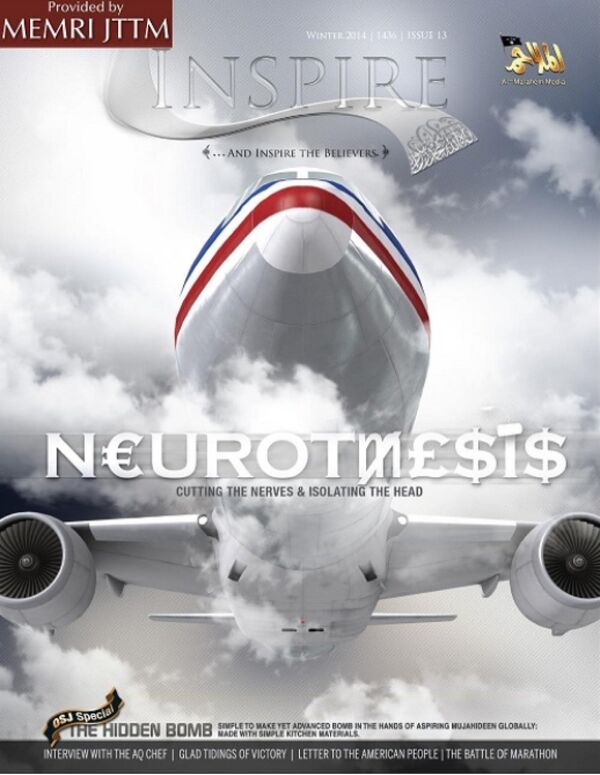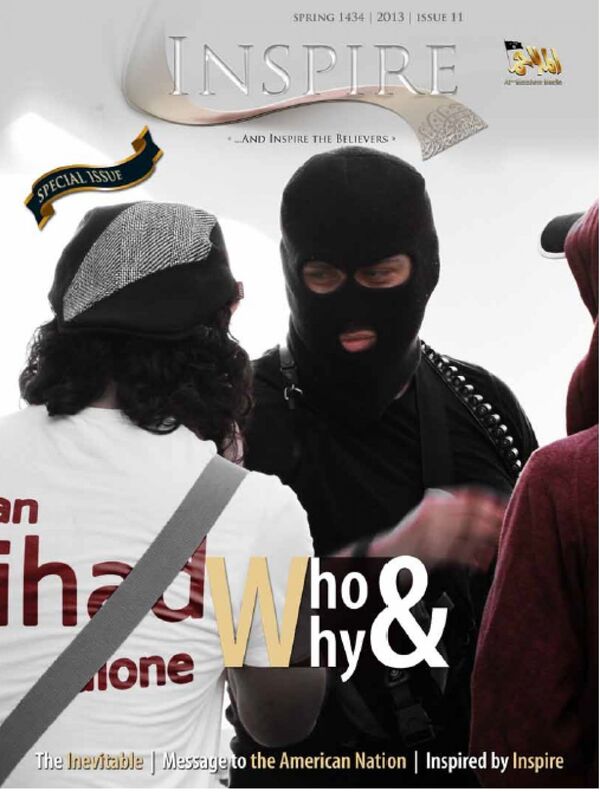MOSCOW, December 31 (Sputnik) — This past week, on December 24, 2014, the Al-Malahem media wing of al-Qaeda in the Arabian Peninsula (AQAP) released its 13th issue of the English-Language magazine Inspire, dated Winter 2014.
Much of the content in the new online magazine is devoted to renewing “jihad on America” and suggests targeting major American figures, Western Commercial airliners, and inspiring lone-wolf terrorist attacks in locations throughout the world.
Al-Qaeda is increasingly seeking to expand its “media jihad,” and is using various formats of social and traditional media, like the Inspire magazine, to act as the virtual connective tissue of the global jihadist movement.
The terrorist organization uses the Internet to share information, coordinate attacks, spread propaganda, and recruit terrorist cells. Al-Qaeda media production groups release a constant stream of media-related products. These vary from video-series, magazines, terrorist ‘how-to’ encyclopedia’s, and even online terrorism courses.
Al-Qaeda’s three main media entities consist of al-Fajr, the Global Islamic Media Front, and as-Sahab and actively assist in the production and distribution of jihadi media materials.
A list of the official groups that make up the al-Qaeda media nexus
|
Title |
Acronym or Short Name |
|
Al-Ansar Mail Group |
Ansar |
|
Al-Isra Media Institute |
Isra |
|
Al-Fajr Media Center |
Fajr |
|
Al-Furqan Media Institute |
Furqan |
|
Al-Sahab Institute for Media Production |
Sahab |
|
Jihadist Media Brigade |
JMB |
|
Jihadist Media Elite |
JME |
|
Echo of Jihad Media Center |
EJMC |
|
Global Islamic Media Front |
GIMF |
|
Media Front of the Islamic Emirate of Afghanistan |
MFT |
These jihadist media groups are transitioning towards a more permanent and structured online presence. Al-Qaeda’s media entities are now undergoing ‘branding’ to help boost credibility and facilitate message control. The daily flow of jihadist media that appears on the internet is now consistently and systematically branded to legitimize online communications from al-Qaeda central to its franchise cells.
These structured and branded al-Qaeda media entities are the ‘nexus’ that receives jihadist media. The material is then spread through a shifting array of online forums.
The Jihadist media products issued by al-Qaeda play an important role in reaching and influencing a mass audience. The propaganda can be a medium for recruitment, provide training and support, strengthen morale within the organization, or help connect the al-Qaeda core to its franchise cells.
In total there have been more than 100 attempted or successful Islamic terrorist attacks in Europe and the United States, according to the Counter Jihad Report, as a result of the sudden increase in online Islamist propaganda.
The new wave of Islamist propaganda, represented in the December 2014 issue of ‘Inspire’, declares a new strategy for al-Qaeda titled “Neurotemesis,” and states (p.63):
“[W]e have placed a policy, renewing what has already been started. We call it ‘Neurotmesis: Cutting the Nerves and Isolating the Head from the Body.’ The nerves of the American war are its economy. We will decapitate America from the rest of the world. Thereupon, we will have reigned supreme in this war. So we have to be innovative and creative and come up with new ways of targeting the American economy, and master in choosing the most effective targets.”

The recent December 2014 Inspire magazine provides a detailed manual on making hidden bombs that can bypass security measures, and a list of specific economic targets. Entitled “The Hidden Bomb”, the article is a central feature which contains explicit instructions for building a portable bomb inside a 17cm plastic water bottle case.
Al Qaeda has also announced new targets for the upcoming year in 2015, including the assassinations of various financial leaders such as Ben Bernanke and Bill Gates.
It warns the financial leaders that they must remove their money from U.S. banks, stop investing in the United States, and declare that they disagree with American policies, in order to not be targeted.
Other targets suggested by Inspire include the World Trade Center, various banks, and forex.
The increase in al-Qaeda’s media products has mirrored a long-term growth of indigenous ‘home-grown’ terrorist cells or ‘lone wolf’ terrorism in the United States and the West.
A well-known magazine, “The Series for Preparation to Jihad” issued by the Global Islamic Media was found downloaded on a computer belonging to the al-Qaeda Madrid cell.
This operational terrorist cell was responsible for the train bombings in Spain in 2004 that killed 191 people.

Extremist Anwar al-Awlaki was prolific on al-Qaeda YouTube channels; among those he influenced were the London terrorists who bombed subways and buses on July 7, 2005.
Most recently, Tamerlan Tsarnaev, the ringleader of the 2013 Boston Marathon Bombings, was reportedly motivated by the propaganda messages of now-deceased al-Qaeda leader Anwar al-Awlaki.
he Tsarnaev brothers had no formal connection to al-Qaeda, yet they used an article from previous Inspire magazines on how to make pressure-cooker bombs. The Boston Marathon Bombings were responsible for killing 3 people and injuring 264.
The Internet is a powerful medium for al-Qaeda to distribute unfiltered propaganda materials on a massive scale. Al-Qaeda is currently winning the ‘war of information’ as the radicalization of home-grown terrorists has become increasingly easier.



